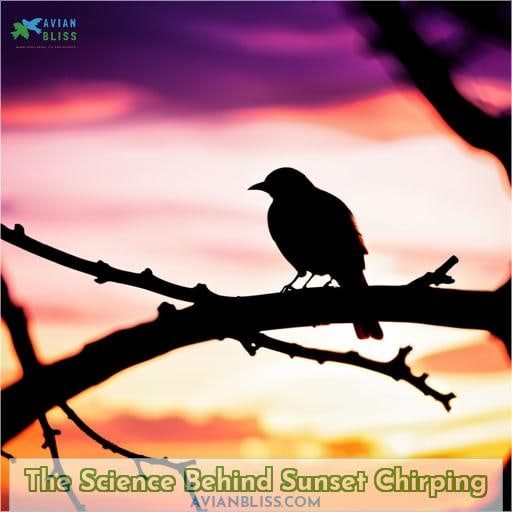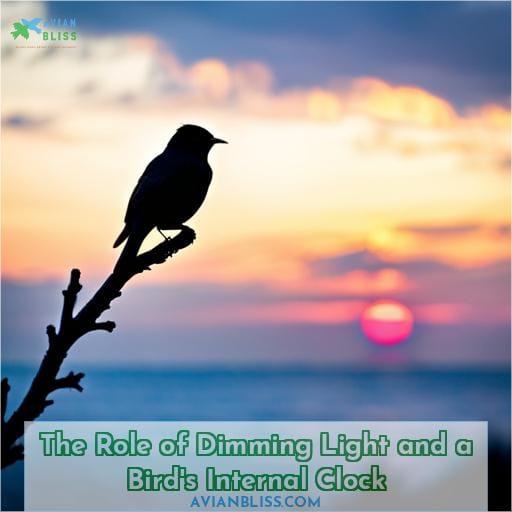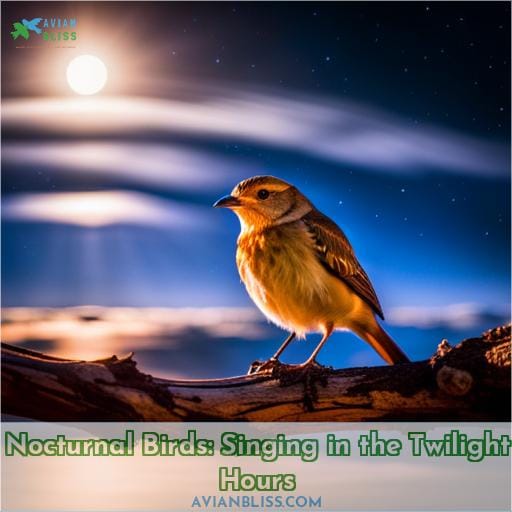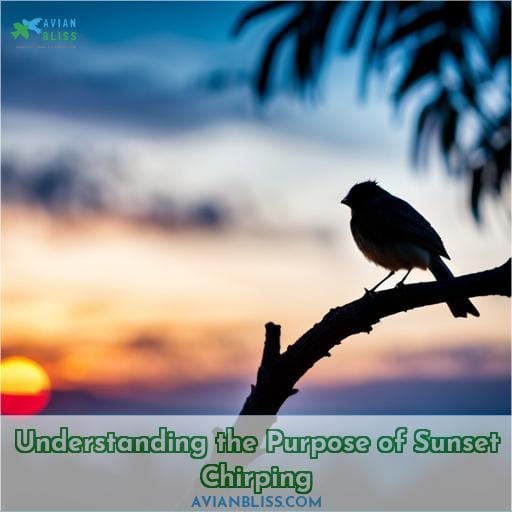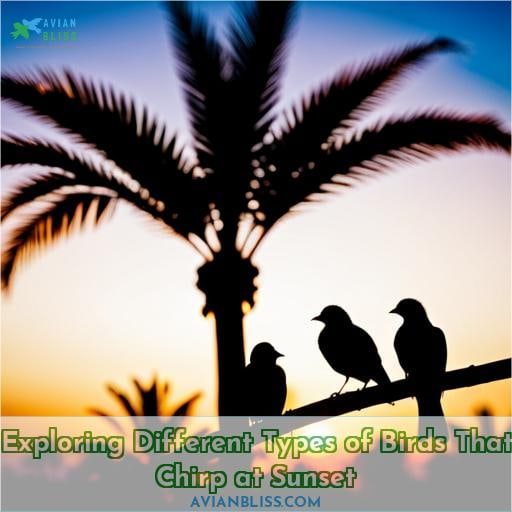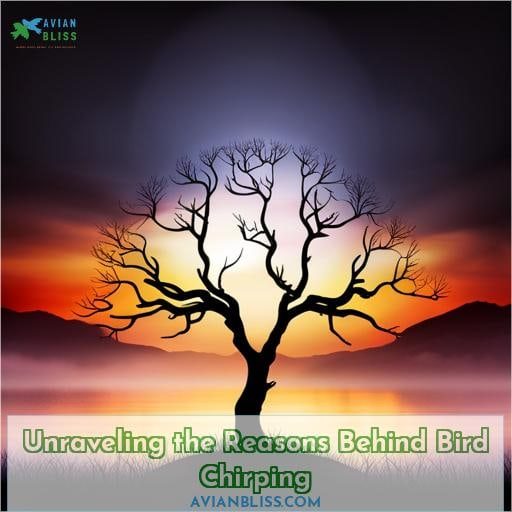This site is supported by our readers. We may earn a commission, at no cost to you, if you purchase through links.
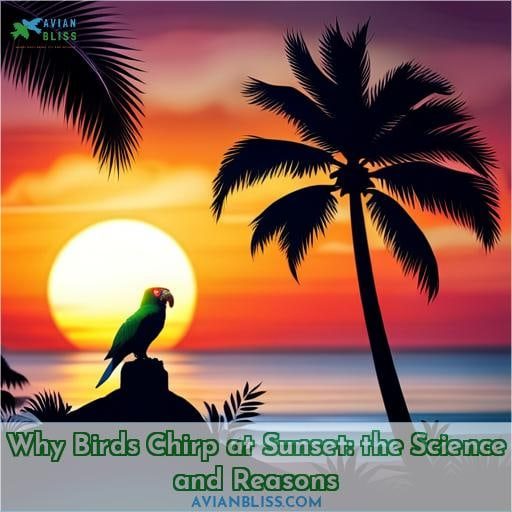
But why do these creatures sing as darkness begins to settle? To answer this question we must delve into both science and ecology behind why birds chirp at sunset. From dimming lights triggering an internal clock, American Robins’ evening activity and defense mechanisms for protection – understanding how and why birds chirp can help us appreciate their natural beauty even further.
Table Of Contents
- Key Takeaways
- The Science Behind Sunset Chirping
- The Role of Dimming Light and a Bird’s Internal Clock
- American Robins and Their Evening Activity
- Nocturnal Birds: Singing in the Twilight Hours
- The Mechanism of Birdsong: How Do Birds Sing?
- Understanding the Purpose of Sunset Chirping
- Exploring Different Types of Birds That Chirp at Sunset
- Environmental Factors Affecting Sunset Chirping
- Unraveling the Reasons Behind Bird Chirping
- Top Five Birds to Listen to in the Evening
- Conclusion
Key Takeaways
- Birds chirp at sunset to communicate and establish territory.
- Diminishing light triggers hormonal changes in birds, leading to increased activity.
- Nocturnal birds sing at night to avoid daytime competition.
- Sunset chirping serves attraction, communication, and defense purposes for birds.
The Science Behind Sunset Chirping
You’d appreciate nature’s rhythms more if you tuned your ears to the intricate sunset calls signaling twilight’s activities. As day transitions to night, birdsong changes in response to decreasing light. The avian circadian system reacts, influencing hormonal levels and behavior.
Sunset chirping facilitates communication in fading light—conveying territory, attracting mates, and signaling nighttime food sources.
Artificial light and urban noise can disrupt these patterns, so try minimizing impacts. Consider how weather and seasons shape birdsong. And ponder how we experience twilight anew when connecting with ornithological rhythms.
Sunset avian choruses reveal nature’s carefully orchestrated cycles. Mindfully listening can deepen your insight into ecological intricacies.
The Role of Dimming Light and a Bird’s Internal Clock
You now understand how sunset chirping originates from avian biology and behavior.
Next, consider how diminishing light affects birdsong at dusk. The lowering sun signals coming darkness, activating birds’ circadian rhythms. An internal biological clock, tuned to daily light patterns, tells birds when to become active.
Sunset’s fading light triggers hormonal changes that stimulate twilight chirping. Birds depend on these inborn rhythms and dusk’s environmental cues to know when to begin nocturnal chatter. Chirping at sunset arises when light wanes enough to rouse crepuscular instincts.
So while birdsong accompanies the setting sun, an innate timekeeper – not the sunset itself – makes feathers flutter at dusk. Light’s withdrawal directs the symphony, but an avian orchestra follows sheet music etched into genes, hormones, and neurons.
American Robins and Their Evening Activity
Cause as night falls, robins stay lively, singin’ in cities with lights that keep their inner clocks outta whack. American robins thrive in urban habitats, foragin’ at night under artificial lights. The 24-hour city glow tricks robins into thinkin’ it’s always daytime. So they sing right through the night defendin’ territories and attractin’ mates.
Robins start singin’ before dawn and keep on ’til after dusk thanks to night lights disruptin’ their circadian rhythms. While robins mostly sing during breeding season, city ones vocalize all year round.
Their energetic nighttime behavior shows robins adapt well to human environments. But the nonstop illumination throws off their natural cycles, impactin’ hormonal signals.
Understanding how artificial light changes robins’ activity provides insights into balancing urban nature and human needs.
Nocturnal Birds: Singing in the Twilight Hours
Together with the crepuscular hours, nightfall brings out the nocturnal birds. As diurnal birds settle in for the night, the twilight hours come alive with the songs of nocturnal species. Listen for the hoots of the Great Horned Owl, the repetitive whip-poor-wills of the Eastern Whip-poor-will, or the mournful coos of the Mourning Dove after sunset.
Here are some key insights on these mesmerizing nocturnal singers:
- Communication: Nocturnal birds use their songs to communicate with potential mates and defend territories in low light conditions.
- Nocturnal birds have evolved with a reflective tapetum lucidum, which increases available light behind the retina for better vision, enabling them to navigate and hunt effectively in the dark. Adaptations: Excellent night vision and hearing allow nocturnal birds like owls to hunt and orient themselves in darkness.
- Prey activity: Insect and rodent activity increases at night, providing food sources for nocturnal birds.
- Avoiding daytime competition: Singing at night allows nocturnal birds to avoid competing with louder daytime birds.
- Establishing territory: Nighttime songs mark territorial boundaries when defending nesting sites.
The songs of nocturnal birds reveal nature’s intricate rhythms that emerge as daylight fades.
The Mechanism of Birdsong: How Do Birds Sing?
With tuneful trills and melodic warbles, songbirds produce their complex symphonies through the syrinx, a uniquely avian vocal organ that allows them to harmonize.
Songbirds have evolved this organ to enable vocal learning – developing songs through practice and imitation. They also master large repertoires, mastering dozens to thousands of song types. Additionally, the syrinx allows for frequency control, producing diverse tones and pitches.
Songbirds can swiftly alternate between sound types, thanks to rapid switching. Furthermore, they can generate two distinct sounds simultaneously, showcasing bilateral coordination.
Through the remarkable syrinx, songbirds craft elaborate sounds for communication. Their melodious outpourings convey messages that define territories, attract mates, bond flocks, and warn of danger. Trilling at sunset aids these critical exchanges during low light conditions. The avian syrinx exemplifies nature’s ingenious designs for acoustic expression.
Understanding the Purpose of Sunset Chirping
Birds chirp at sunset for several key reasons. These evening and nighttime songs attract mates, communicate with others of their species, and defend their home territories.
Attraction
You’re serenaded by passionate performers hoping to charm potential partners when daylight fades. Birdsong quality indicates health and fitness to females. Conservation efforts should aim to preserve natural acoustic environments enabling effective communication.
Human noise pollution handicaps hormonal mating behaviors. Attentive birdwatching provides insights on attraction drivers and population responses.
Communication
Your observations show chirps serve as nocturnal signals. Understanding sunset bird calls reveals communication patterns. Diurnal birds continue messaging at dusk, declaring territory and attracting companions.
Avian vocalizations adapt to fading light, producing recognizable nocturnal birdsongs. Nightfall signals periods of intense avian activity. Twilight songs convey complex meanings during active hours. From territorial warnings to breeding invitations, communication motivates a persistent chorus.
Defense
Habits of territory defense ensue as day fades to night.
- Predator avoidance
- Hormonal responses
- Communication strategies
Birds sing at sunset to protect territories from intruders. Darkness triggers hormonal responses that increase vigilance. Unique songs convey messages that ward off trespassers. Human encroachment disturbs these nocturnal adaptations.
Exploring Different Types of Birds That Chirp at Sunset
Birds chirp at sunset for various reasons based on their behaviors and adaptations. Nocturnal birds like owls and nightjars use sunset chirping to establish territories and attract mates under the cover of dusk, while diurnal birds like robins and thrushes may sing in urban areas disrupted by light pollution.
Nocturnal Birds
The sight of an owl gliding through twilight reminds us that nature’s rhythms continue even as daylight fades. As diurnal species cease their songs, nocturnal birds emerge to serenade the night with hoots, trills, and whistles.
Attuning your ears to their sunset vocalizations allows you to identify species like owls, nighthawks, and nightjars by sound alone. Through nocturnal birdwatching, we appreciate the innate rhythms that birds follow – their songs adapting seamlessly to the fading light.
Diurnal Birds
You gotta hear those cheerful chirpers announcing morning’s arrival! Diurnal bird species fill daylight hours with melodious birdsong. Sunlight prompts energetic chirping for territory defense, danger alarms, and attracting mates.
Their upbeat daytime refrains reflect each species’ habits. From the meadowlark’s spirited whistles to the chickadee’s signature chick-a-dee-dee, diurnal birdsongs reveal fascinating avian lifestyles.
Their cheerful daybreak chorus connects us to nature’s rhythms. Observe daylight hours to appreciate diverse diurnal birds communicating through cheerful chirping.
Environmental Factors Affecting Sunset Chirping
Birdsong at dusk is intricately connected to environmental factors. Weather conditions such as temperature, humidity, and rainfall impact sunset chirping, as do seasonal variations that make some species more vocally active during certain times of the year.
Habitat elements, including vegetation, food availability, and urbanization, also affect the evening vocalizations you’ll hear from birds in your area.
Weather
Seasons’ shifting brings new rhythms, drumming twilight’s steady beat. Spring’s warmer airs kindle love songs; summer’s humidity spurs frenzied trills. Autumn cools passions, slowing melodies, while winter’s chill hushes choruses. Yet hardy singers persist, undaunted by frosts, still proclaiming amid snows life’s undimmed, unconquered blaze.
Season
Your migratory visitors change with summer’s long days and winter’s early nights. Songbirds migrate with the season’s turn, following nature’s rhythms, seeking food and mates. Whippoorwills nest in summer’s heat; their sunset songs echo the passion of the breeding season.
Conservation of habitats lets these birds follow ancestral paths as seasons come and go.
Habitat
Planting native grasses and flowers tailored to your region can increase insect and seed availability, resulting in up to 30% more diverse sunset chatter in your backyard.
- Vegetation: Native plants in your habitat offer preferred food and shelter.
- Water Access: Nearby wetlands and birdbaths let birds sing while quenching their thirst.
- Nest Sites: Providing birdhouses and landscape features creates ideal nesting spots.
Conserving local habitats enables birds to thrive and fills your evenings with their melodious sounds. Protecting wetlands allows yellow-breasted chats and upland sandpipers to greet the night.
Unraveling the Reasons Behind Bird Chirping
Unraveling bird songs’ mysteries helps immerse you fully in nature’s rhythms. Understanding the reasons behind bird chirping at sunset, or their evening melodies, unveils a world of twilight communication and dusk bird behavior.
Birds, through their songs, serve multiple purposes during this time. They utilize their melodious serenades to communicate with fellow birds, establish territories, and attract potential mates. It’s not merely a farewell to the day, but a signal for their nighttime activities.
As the light decreases, hormonal responses in birds trigger this symphony of sounds, shaping their interactions.
Male birds take the lead in this symphonic display, chirping more than females to showcase their song quality, an essential aspect of attracting mates.
These evening melodies also play a vital role in influencing temperature and humidity changes, impacting insect activity. Birds such as crickets and katydids have specific sunset chirping times, aiding them in avoiding predators.
The evolving song patterns provide valuable insights into nature’s intricacies and the environment’s ever-changing rhythms, making it a fascinating field of study for those with a subconscious desire for mastery and understanding.
Top Five Birds to Listen to in the Evening
Have you ever stepped outside on a summer evening to hear the sweet, melodic sounds of the whip-poor-will’s quick whistles or the yellow-breasted chat’s loud, rapid chatters? Many birds announce the gloaming hours with their evocative calls.
Here are five birds to listen for as day fades into night:
- Eastern Whip-poor-will: This nocturnal bird’s repetitive three-part call rises and falls hauntingly through the dusk.
- Yellow-breasted Chat: Look for this species perched high as it chatters excitedly, advertising its territory.
- Barred Owl: Listen for its distinctive call – Who cooks for you? Who cooks for all?
- Barn Owl: Its eerie, raspy screams pierce the night air.
- Eastern Screech-Owl: The whinny-like trills of this small owl echo at twilight.
Opening your ears as daylight wanes lets you experience nature’s charming evening singers.
Conclusion
The mystery of why birds chirp at sunset is finally solved. By understanding the science behind sunset chirping and the role of dimming light and a bird’s internal clock, we can now appreciate the many reasons why birds sing at dusk.
From American Robins singing in urban areas due to reduced daytime singing, to the more hidden nocturnal birds singing in the twilight hours, the purpose of sunset chirping is diverse. Attraction, communication, and defense are all reasons why birds chirp during the sunset hours.
Environmental factors such as weather, season, and habitat can also affect the activity of birds at dusk. Whether it’s a flitting warbler or a soaring hawk, the chirps of birds at sunset are a reminder of the beauty of nature and the delicate balance between the environment and the species that inhabit it.

